nnnnnnnnnnnn TOP nnnnnnnnnnnnn
Digest January 2006
.................................. January 2006
Me-aka Fudo, the Red-eyed Fudo 目赤不動
also : Aka-Fudoo, The RED FUDO 赤不動
Yonago Daruma 米子だるま Papermachee Doll
Miso Jizoo, the Bean Paste Jizo みそ地蔵, ミソ地蔵, 味噌地蔵
Daiza, the Seat of Buddha 台座
Aizen Myo-O 愛染明王
Niutsuhime 丹生都比女 Mercury and Mountain Lore
Kagura Dance 神楽
Meguro Fudo Temple 目黒不動
Osame-Fudo, Last Fudo Rituals of the Year - 納不動
Donald Keene about his Life in Japan
**********************
Please send your contributions to Gabi Greve
Daruma Discussion Forum
Alphabetical Index of the Daruma Museum
:::::::::::::::::::::::::::::::::::::::::::::::::::::::::::::::::::::::::::::::::::::::::::::::::::::
worldkigo
1/31/2006
1/26/2006
LOGO and Banners
[ . BACK to Daruma Museum TOP . ]
:::::::::::::::::::::::::::::::::::::::::::::::::::::::::::::::::::::::::::::::::::::::::::::::::::::
DARUMA LOGO in the Internet
:::::::::::::::::::::::::::::::::::::::::::::::::::::::::::::::::::::::::::::::::::::::::::::::::::::

DARUMA LOGO ... online

:::::::::::::::::::::::::::::::::::::::::::::::::::::::::::::::::::::::::::::::::::::::::::::::::::::


MORE
Dharma Logo ... online
Yin-Yang ... Yin and Yang Duality
My Daruma Museum
:::::::::::::::::::::::::::::::::::::::::::::::::::::::::::::::::::::::::::::::::::::::::::::::::::::

Shelma Antiques
Chee de Waterloo, 417. 1050 Brussels
http://www.schelma.com/english/od.dir/od1004.html
:::::::::::::::::::::::::::::::::::::::::::::::::::::::::::::::::::::::::::::::::::::::::::::::::::::

Online Shop
© www.daruma-shop.de
:::::::::::::::::::::::::::::::::::::::::::::::::::::::::::::::::::::::::::::::::::::::::::::::::::::

Restaurant
© www.daruma.co.za
:::::::::::::::::::::::::::::::::::::::::::::::::::::::::::::::::::::::::::::::::::::::::::::::::::::


The Daruma Doll that inspired the mikoto skull logo .
Buy This Design on a American Aparrel T from Redbubble
source : www.mikoto.com.au
:::::::::::::::::::::::::::::::::::::::::::::::::::::::::::::::::::::::::::::::::::::::::::::::::::::
The Meaning of the Jidokwan Logo

The center figure is a representation of Bodhidarma, also known as Daruma or Tamo. The traditional Daruma figure is a balanced figure that will not stay down if knocked over, it will right itself automatically. This automatic righting is representative of the Buddhist saying "Seven times down, eight times up". This is a common saying amoung early Jidokwan members.

source : www.taekwondojidokwan.com
:::::::::::::::::::::::::::::::::::::::::::::::::::::::::::::::::::::::::::::::::::::::::::::::::::::
AEON shop イオンショップ

source : www.aeonshop.com
:::::::::::::::::::::::::::::::::::::::::::::::::::::::::::::::::::::::::::::::::::::::::::::::::::::::

Logo name: Daruma sushi
Nation: Russian Federation
Client: Daruma sushi bar
The image is a stylized face of the doll that has features of a samurai as another characteristic icon of Japan.
- source : www.wolda.org/showcase/logo
:::::::::::::::::::::::::::::::::::::::::::::::::::::::::::::::::::::::::::::::::::::::::::::::::::::::
Daruma no RU, る 、 from Matsukawa
:::::::::::::::::::::::::::::::::::::::::::::::::::::::::::::::::::::::::::::::::::::::::::::::::::::
Alphabetical Index of the Daruma Museum
:::::::::::::::::::::::::::::::::::::::::::::::::::::::::::::::::::::::::::::::::::::::::::::::::::::
worldkigo
:::::::::::::::::::::::::::::::::::::::::::::::::::::::::::::::::::::::::::::::::::::::::::::::::::::
DARUMA LOGO in the Internet
:::::::::::::::::::::::::::::::::::::::::::::::::::::::::::::::::::::::::::::::::::::::::::::::::::::

DARUMA LOGO ... online

:::::::::::::::::::::::::::::::::::::::::::::::::::::::::::::::::::::::::::::::::::::::::::::::::::::


MORE
Dharma Logo ... online
Yin-Yang ... Yin and Yang Duality
My Daruma Museum
:::::::::::::::::::::::::::::::::::::::::::::::::::::::::::::::::::::::::::::::::::::::::::::::::::::

Shelma Antiques
Chee de Waterloo, 417. 1050 Brussels
http://www.schelma.com/english/od.dir/od1004.html
:::::::::::::::::::::::::::::::::::::::::::::::::::::::::::::::::::::::::::::::::::::::::::::::::::::

Online Shop
© www.daruma-shop.de
:::::::::::::::::::::::::::::::::::::::::::::::::::::::::::::::::::::::::::::::::::::::::::::::::::::

Restaurant
© www.daruma.co.za
:::::::::::::::::::::::::::::::::::::::::::::::::::::::::::::::::::::::::::::::::::::::::::::::::::::


The Daruma Doll that inspired the mikoto skull logo .
Buy This Design on a American Aparrel T from Redbubble
source : www.mikoto.com.au
:::::::::::::::::::::::::::::::::::::::::::::::::::::::::::::::::::::::::::::::::::::::::::::::::::::
The Meaning of the Jidokwan Logo

The center figure is a representation of Bodhidarma, also known as Daruma or Tamo. The traditional Daruma figure is a balanced figure that will not stay down if knocked over, it will right itself automatically. This automatic righting is representative of the Buddhist saying "Seven times down, eight times up". This is a common saying amoung early Jidokwan members.
source : www.taekwondojidokwan.com
:::::::::::::::::::::::::::::::::::::::::::::::::::::::::::::::::::::::::::::::::::::::::::::::::::::
AEON shop イオンショップ

source : www.aeonshop.com
:::::::::::::::::::::::::::::::::::::::::::::::::::::::::::::::::::::::::::::::::::::::::::::::::::::::

Logo name: Daruma sushi
Nation: Russian Federation
Client: Daruma sushi bar
The image is a stylized face of the doll that has features of a samurai as another characteristic icon of Japan.
- source : www.wolda.org/showcase/logo
:::::::::::::::::::::::::::::::::::::::::::::::::::::::::::::::::::::::::::::::::::::::::::::::::::::::
Daruma no RU, る 、 from Matsukawa
:::::::::::::::::::::::::::::::::::::::::::::::::::::::::::::::::::::::::::::::::::::::::::::::::::::
Alphabetical Index of the Daruma Museum
:::::::::::::::::::::::::::::::::::::::::::::::::::::::::::::::::::::::::::::::::::::::::::::::::::::
worldkigo
1/15/2006
Daiza Seat
[ . BACK to WORLDKIGO TOP . ]
:::::::::::::::::::::::::::::::::::::::::::::::::::::::::::::::::::::::::::::::::::::::::::::::::::::
Daiza, the Seat of Buddha 台座
The text below in German if from my own book.
:::::::::::::::::::::::::::::::::::::::::::::::::::::::::::::::::::::::::::::::::::::::::::::::::::::
Some samples of dias forms:
Quoted from : 仏像の基本形
Copyright© 1997-2005 仏像世界.
Takada Hiroshi
http://www.geocities.jp/butsuzo1220/index.html
Lotus Seat, Rengeza 蓮華座 (れんげざ)

xxxxxxxxxxxxxxxxxxxxxxxxxxxxx
Cloud seat, Unza 雲座 (うんざ)
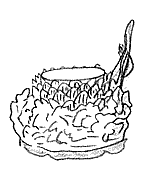
xxxxxxxxxxxxxxxxxxxxxxxxxxxxx
Seat like the Mountain of the World, Shumisen, Mt. Sumeru
Senjiza 宣字座(須弥座)(せんじざ(しゅみざ))

xxxxxxxxxxxxxxxxxxxxxxxxxxxxx
Seat like a lotus leaf, Kayooza 荷葉座 (かようざ)
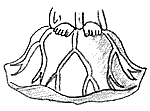
xxxxxxxxxxxxxxxxxxxxxxxxxxxxx
Rock seat, Iwaza 岩座 (いわざ)

xxxxxxxxxxxxxxxxxxxxxxxxxxxxx
Honorific Seat, Diamond Seat,
Shitsushitsuza 瑟瑟座 (しつしつざ)

http://www.geocities.jp/butsuzo1220/buddha/html/bkihon.html
:::::::::::::::::::::::::::::::::::::::::::::::::::::::::::::::::::::::::::::::::::::::::::::::::::::
Whilst relying on my research book, I also add some online material now. I follow the order of the German translations.
A wonderful source apart from Mark Schumacher All about Buddha Statues is the following:
JAANUS
(C) 2001 Japanese Architecture and Art Net Users System.
http://www.aisf.or.jp/%7Ejaanus/
Check all the JAANUS links given for more information on the subject.
oooooooooooooooooooooooooooooooooooooooooo
Seat, pedestal, dias, daiza 台座
A pedestal or dais upon which a Buddhist image is placed.
The type of pedestal is related to the type of image it supports as well as the period in which it was made. The *rengeza 蓮華座 or lotus pedestal is one of the most common forms of base for Buddha and Bodhisattva images. In its simplified form it consists of a *kaeribana 反花 (a ring of lotus petals facing downward). In its complex form it has many levels and various components.
Extensive explanation is here:
http://www.aisf.or.jp/~jaanus/deta/d/daiza.htm
Seat covered with a woolen blanket, kuyuza くゆ座
Also senkuza 氈く座, kyuuza 毬座 or mousenza 毛氈座. A dais (daiza 台座) for an image of a heavenly being (ten 天) in the shape of a round woolen rug with tassels around the edge.
http://www.aisf.or.jp/~jaanus/deta/k/kuyuza.htm
Demon dias, kiza 鬼座 邪鬼・鬼座
Statues of a heavenly being (ten天) stand on the bodies of Amanojaku demons, some form of ancient Indian deities, which offer their bodies for the Buddhas to stand in more comfort.
Look at an example of Mark Schumacher
http://www.onmarkproductions.com/html/shitenno.shtml
Diamant Dias (kongooza, kongoozai; vajrasana 金剛座)
The center of the world. The original place in Bodhgaya, where Shakyamuni sat down to come to enlightenment. All Buddhas use this seat to sit in meditation until enlightenment.
One-Leaf Dias, ichiyooza 一葉座
One signle lotus leaf, in which the statue of a Kannon is seated.
See also > kayooza.
gem or precious stone base, shitsushitsuza 瑟瑟座
The most common base for an image of Fudou Myouou 不動明王, especially in a group with four others, godai myoo-o 五大明王.
See illustration above.
http://www.aisf.or.jp/~jaanus/deta/s/shitsushitsuza.htm
Robe-covered dias, mokakeza, kakemoza, senkuza 裳懸座
A pedestal which is covered by the skirt of the Buddhist image it supports.
http://www.aisf.or.jp/~jaanus/deta/m/mokakeza.htm
Stone pedestal, banjakuza, iwaza, ganza 盤石座, 岩座
images of guardian figures and Myouou 明王 most commonly have rock bases.
Sometimes figures of demons are engraved in the stone.
See illustration above.
http://www.aisf.or.jp/~jaanus/deta/i/iwaza.htm
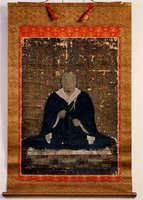 Podest for a figure of a saint, Honorable Seat, raibanza 礼盤座
Podest for a figure of a saint, Honorable Seat, raibanza 礼盤座
Sometimes arabesques are encarved on the sides of the simple square seat.
Saint Shinran seated on a square podest
http://www5a.biglobe.ne.jp/~kenshoji/homotu/goei.html
Lotus Pedestal, rengeza; padmasana 蓮華座
the most common forms of base for Buddha and Bodhisattva images.
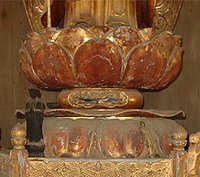
Read the details at JAANUS
http://www.aisf.or.jp/~jaanus/deta/r/rengeza.htm
Lotus-Leaf Dias, kashooza, kayooza 荷葉座
Form of an upside down lotus leaf. For statues of Ten. Often used in esoteric Buddhism. See illustration above.
Podest with a vase of treasures, hoobyoozuke rengedai 宝瓶付蓮華台
Only for Aizen Myo-O 愛染明王
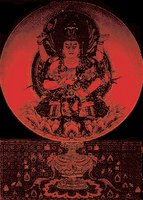
http://www.sakai.zaq.ne.jp/piicats/aizennZ.htm
lotus base with separate feet, fumiwari rengeza 踏割蓮華座, fumiwake rengeza 踏分蓮華座
Mostly for standing statues of Amida Nyorai, sometimes Fudo Myo-O.
:::::::::::::::::::::::::::::::::::::::::::::::::::::::::::::::::::::::::::::::::::::::::::::::::::::
Sockelformen (daiza)
Fast alle Figuren sitzen oder stehen auf einem besonderen Thron bzw. Sockel, der ausdrückt, daß die Gottheiten keinen direkten Kontakt mit dieser Welt haben. Am beliebtesten ist der Lotussockel, da er symbolisch das Erheben über den Schmutz und Schlamm dieser Welt verdeutlicht. Wer einmal einen Lotusteich im Sommer erlebt hat, wird diese Assoziation sicher nachempfinden können.
Bedeckter Sockel (kuyuza)
Spezieller Sockel für Ten-Statuen; mit aufgelegter Wolldecke.
Dämonensockel (kiza)
Dämonenfiguren, auf denen die Ten-Statuen stehen.
Diamantsockel (kongooza, kongoozai; vajrasana)
Der unverrückbare Mittelpunkt der Welt, Symbol der transzendenten, ewigen, diamantgleichen unzerstörbaren Wahrheit. Der Sitz, auf dem Shakyamuni under dem Bodhi-Baum meditierte und schließlich die Erleuchtung erlangte. Alle in diesem Zeitalter lebenden Buddhas erlangen auf diesem Sitz die Erleuchtung.
Ein-Blatt-Sockel (ichiyoo)
Ein einziges Lotusblatt, auf dem eine Kannon-Statue (Ichiyoo Kannon) sitzt.
Erhabener Sockel (shitsushitsuza)
"Edelsteinsitz".
Mehrstufiger, eckiger Sockel eines Myo-O. Ein fester Sockel aus mehreren, unregelmäßig geschichteten Brettern. Meist bunt bemalt. Eine abstrakte Form des Felssockels. Häufig bei einem Fudoo Myo-O, wenn er die mittlere Figur einer Gruppe der fünf großen Myo-O bildet.
Falten-Sockel (mokakeza, kakemoza, senkuza)
Sockel, über den das Gewand (mo) der Statue gebreitet ist. Meist über einem Weltenberg-Sockel. Häufig bei alten Statuen, z.B. des Shaka Nyorai im Tempel Hooryuuji. In der Fujiwara-Zeit auch für Ten-Statuen, besonders Kichijooten.
Felssockel (banjakuza, iwaza, ganza)
Sockel in Form natürlicher Felsen.
Fast ausschließlich für Myo-O, Ten oder noch niederere Gotthei~ten mit furchterregendem Gesichtsausdruck. Auf dem Stein können sich auch noch Dämonen-Figuren befinden, auf denen die Myo-O trampeln. Siehe Dämonensockel.
Heiligen-Sockel (raibanza)
Kleiner Sockel mit Arabeksen an den Seiten; für Figuren von Heiligen und Priestern
Lotussockel (rengeza; padmasana)
Massiver oder einfacher Lotussockel. Die häufigste Sockelform für Nyorai-Figuren.
Blütenschale des Erleuchtungs-, Reinheits- und Weltsymbols.
Lotus blüht im Paradies des Westens.
Für Nyorai, Bosatsu und selten Myo-O.
..... Kurze historische Entwicklung:
In der Asuka-Zeit hatte ein Lotussockel nur eine Schicht einfache Lotusblätter. In der Hakuhoo-Zeit sind die Lotusblätter walnuß~förmig, in zwei Lagen übereinander geschichtet. In der Tempyoo-Zeit werden die Enden spitz zulaufend, zu Beginn der Heian-Zeit relativ breit. In der Fujiwara-Zeit sind die Lotusblätter dünn und in der Kamakura-Zeit einfach realistisch nachgebildet.
Einzelne Teile eines klassischen Lotussockels (von oben nach unten):
Rengebu, Shibe, Renniku, Renben
Fukijiku
Uwashiki nasu
Keban
Shitashiki nasu, Ukebana
Ukeza, Kesoku
Kaeribana
Hamaguriza
Uwa kamachi
Shita kamachi
Sumiashi
..... Erläuterungen zum mehrstufigen Lotussockel:
fukijiku Gerader Teil direkt unterhalb der Lotusblätter.
kaeribana Nach oben gebogene untere Lotusblätter. Symbolisieren eine voll aufgeblüte Blüte. Darunter die beiden kamachi.
keban Zweite Plattform, auf der die Lotusblätter (renben) stehen. Symbolisieren die glatten Blätter auf dem Wasser. Sie werden vom ukeza getragen.
kesoku Lotusblätter um dem ukeza.
renben, rengebu Lotusblätter.
rennikubu Glatter Teil eines mehrstufigen Lotussockels.
shibe Staubfäden. Oberster Teil.
shitashiki nasu Kastenförmiger mittlerer Teil. Symbolisiert die Wurzeln, welche Stengel und Blüten nähren.
shita kamachi Unterer eckiger Teil des untersten Teils. Siehe uwa kamachi. Oft mit acht Ecken.
sumiashi Eckfüße.
ukeza Gerader Teil unter dem shitashiki nasu.
uwa kamachi Oberer eckiger Teil des untersten Teils. Symbolisiert zusammen mit shita kamachi das Sumpfwasser, über dem sich die Blüte erhebt. Oft mit acht oder sechs Ecken.
uwashiki nashi Kastenförmiger oberer Teil.
Lotusblatt-Sockel (kashooza, kayooza)
Kleiner Sockel in Form eines umgedrehten Lotusblattes; für Ten und niedere Gottheiten, die nicht auf einem echten Lotussockel stehen dürfen. Häufig für Daikokuten und Kichijooten. Wichtige Sockelform im esoterischen Buddhismus.
Lotus-Schatzsockel (hoobyoozuke rengedai)
Lotussockel mit einer Vase (kenbyoo, kembyoo) mit Schätzen darunter. Nur Aizen Myôô.
Lotusteich-Sockel (renga)
Eine Lotusblüte, auf der eine Kannon-Figur sitzt, aus einem Teich aufragend.
Löwensockel (shishiza; simhasana)
Symbol der erweckenden Verkündung, des unbezwingbaren Herrschertums, Mut und transzendenter Weisheit.
Oft steht auf dem Löwenrücken ein weiterer Sockel in der Form des Weltenberges Sumeru. Häufig bei Monju Bosatsu.
Siehe Tierform-Sockel.
Muschelsockel (hamaguriza, koori)
Gewölbter Teil unter dem kaeribana-Teil eines mehrstufigen Lotussockels. Auch einfacher Muschelsockel für eine Kannon-Figur.
Rechtecksockel (kataza)
Einfaches Rechteck aus Holz für eine stehende Figur.
Schritt-Sockel (fumiwariza, fumiwari renza 踏み割り座)
Zwei kleine Lotussockel unter jedem Fuß einer stehenden bzw. "laufenden" Figur. Häufig für Myo-O, selten auch bei Amida Nyorai.
Sitzplatz (kyokurokuza)
Sitz in Stuhlform für einen hohen Priester, z.B. Kooboo Daishi.
"Strahlender Berg"-Sockel (koomyoosan, koomuoozan)
Spezieller Sockel einer Wunscherfüllenden Kannon. Mit überwältigendem Wurzelwerk, bei dem der Hersteller seine Individualität ausleben kann. Eine Hand der Figur liegt stützend auf diesem Sockel, damit der "Strahlende Berg" mit dem Lotussockel nicht ins Wackeln gerät.
Tatami-Sockel (joojooza, agetatamiza)
Einfacher, flacher, viereckiger Strohmatten-Sockel mit farbiger Einfassung; für Statuen von niederen Gottheiten oder Priesterfiguren.
Tierform-Sockel (kinjuuza, choojuuza)
Wichtige Sockelform im esoterischen Buddhismus.
Elefant, Löwe, Phönix, Wasserbüffen, Gans u.a. Tiere.
Ein weißer Elefant steigt aus dem Tushita-Himmel herab, erscheint der Mutter des Shakyamuni, Maya, und kündigte ihr die Geburt des Sohnes an. Daher wird der Elefant in Indien besonders verehrt.
Elefant mit sechs Zähnen als Symbol der Stärke, Klugheit, machtvoller Würde, Unveränderlichkeit und Tugend der Meditation.
Fugen Bosatsu sitzt auf einem weißen Elefanten mit sechs Stoßzähnen. Monju Bosatsu sitzt auf einem Löwen.
Taishakuten sitzt auf einem weißen Elefanten, ein Bein herunterhängend.
Ashuku Nyorai sitzt ebenfalls auf einem weißen Elefanten.
Garuda-Vogel (kinshichoo), bedeutet Sieg über alle Elemente. Fukuu Jooju Nyorai sitzt darauf.
Pfau bedeutet Schönheit und macht Giftstoffe unwirksam. Kujaku Myo-O reitet auf einem Pfau.
Daijizaiten sitzt auf einem Wasserbüffel.
Die meisten Figuren sitzen auf einem Lotussockel auf dem Rücken des entsprechenden Tieres, z.B. auf einem Elefanten (kizoozoo), auf einem Löwen (shishiza, kishizoo).
Ausnahmen:
Dakiniten sitzt direkt auf einem weißen Fuchs.
Emmaten manchmal auf einem Wasserbüffel.
Marishiten steht auf einem Wildschwein.
Myooken Bosatsu und der Wassergott stehen auf einem grünen Drachen oder einer Schildkröte.
Wolkensockel (unza, kumoza)
Wolkenförmiger Sockel für engelartige Himmelswesen (gandharva; Apsara). Häufig in Fujiwara- und Kamakura-Zeit; besonders schöne Versionen im Tempel Byoodooin.
Weltenberg-Sockel (shumiza, sumiza, senjiza)
Sockel als Verkörperung des Weltenberges Sumeru. Sockel eines Nyorai oder Bosatsu, viereckig oder achteckig. Ein mittlerer Block wird oben und unten von einem Brett abgedeckt, sieht ähnlich aus wie das chinesische Zeichen "sen", daher der Name "Sockel wie das chinesische Schriftzeichen SEN" (senjiza). Unten meist mit drei Stufen. Manchmal fließen die Gewänder über den vorderen Teil dieses Sockels (siehe Faltensockel).
Wellensockel (suhamaza)
Sockel wie eine Sandbank.
Sockel einer stehenden Figur; mehrere Schichten wie Wellen an einer Küste. Eine Art der Felsensockel. Häufig in der Tempyoo-Zeit für niedere Gottheiten.
Quoted from my book:
Greve, Gabriele
Buddhastatuen - Who is Who
Paradise Publishers, Kamakura 1994
Japanese Art and Culture: Literature by Gabi Greve
. Buddhistische Kultgegenstände Japans
by Gabi Greve
Paradise Publishers 1996.
:::::::::::::::::::::::::::::::::::::::::::::::::::::::::::::::::::::::::::::::::::::::::::::::::::::
worldkigo
:::::::::::::::::::::::::::::::::::::::::::::::::::::::::::::::::::::::::::::::::::::::::::::::::::::
Daiza, the Seat of Buddha 台座
The text below in German if from my own book.
:::::::::::::::::::::::::::::::::::::::::::::::::::::::::::::::::::::::::::::::::::::::::::::::::::::
Some samples of dias forms:
Quoted from : 仏像の基本形
Copyright© 1997-2005 仏像世界.
Takada Hiroshi
http://www.geocities.jp/butsuzo1220/index.html
Lotus Seat, Rengeza 蓮華座 (れんげざ)

xxxxxxxxxxxxxxxxxxxxxxxxxxxxx
Cloud seat, Unza 雲座 (うんざ)

xxxxxxxxxxxxxxxxxxxxxxxxxxxxx
Seat like the Mountain of the World, Shumisen, Mt. Sumeru
Senjiza 宣字座(須弥座)(せんじざ(しゅみざ))

xxxxxxxxxxxxxxxxxxxxxxxxxxxxx
Seat like a lotus leaf, Kayooza 荷葉座 (かようざ)

xxxxxxxxxxxxxxxxxxxxxxxxxxxxx
Rock seat, Iwaza 岩座 (いわざ)

xxxxxxxxxxxxxxxxxxxxxxxxxxxxx
Honorific Seat, Diamond Seat,
Shitsushitsuza 瑟瑟座 (しつしつざ)

http://www.geocities.jp/butsuzo1220/buddha/html/bkihon.html
:::::::::::::::::::::::::::::::::::::::::::::::::::::::::::::::::::::::::::::::::::::::::::::::::::::
Whilst relying on my research book, I also add some online material now. I follow the order of the German translations.
A wonderful source apart from Mark Schumacher All about Buddha Statues is the following:
JAANUS
(C) 2001 Japanese Architecture and Art Net Users System.
http://www.aisf.or.jp/%7Ejaanus/
Check all the JAANUS links given for more information on the subject.
oooooooooooooooooooooooooooooooooooooooooo
Seat, pedestal, dias, daiza 台座
A pedestal or dais upon which a Buddhist image is placed.
The type of pedestal is related to the type of image it supports as well as the period in which it was made. The *rengeza 蓮華座 or lotus pedestal is one of the most common forms of base for Buddha and Bodhisattva images. In its simplified form it consists of a *kaeribana 反花 (a ring of lotus petals facing downward). In its complex form it has many levels and various components.
Extensive explanation is here:
http://www.aisf.or.jp/~jaanus/deta/d/daiza.htm
Seat covered with a woolen blanket, kuyuza くゆ座
Also senkuza 氈く座, kyuuza 毬座 or mousenza 毛氈座. A dais (daiza 台座) for an image of a heavenly being (ten 天) in the shape of a round woolen rug with tassels around the edge.
http://www.aisf.or.jp/~jaanus/deta/k/kuyuza.htm
Demon dias, kiza 鬼座 邪鬼・鬼座
Statues of a heavenly being (ten天) stand on the bodies of Amanojaku demons, some form of ancient Indian deities, which offer their bodies for the Buddhas to stand in more comfort.
Look at an example of Mark Schumacher
http://www.onmarkproductions.com/html/shitenno.shtml
Diamant Dias (kongooza, kongoozai; vajrasana 金剛座)
The center of the world. The original place in Bodhgaya, where Shakyamuni sat down to come to enlightenment. All Buddhas use this seat to sit in meditation until enlightenment.
One-Leaf Dias, ichiyooza 一葉座
One signle lotus leaf, in which the statue of a Kannon is seated.
See also > kayooza.
gem or precious stone base, shitsushitsuza 瑟瑟座
The most common base for an image of Fudou Myouou 不動明王, especially in a group with four others, godai myoo-o 五大明王.
See illustration above.
http://www.aisf.or.jp/~jaanus/deta/s/shitsushitsuza.htm
Robe-covered dias, mokakeza, kakemoza, senkuza 裳懸座
A pedestal which is covered by the skirt of the Buddhist image it supports.
http://www.aisf.or.jp/~jaanus/deta/m/mokakeza.htm
Stone pedestal, banjakuza, iwaza, ganza 盤石座, 岩座
images of guardian figures and Myouou 明王 most commonly have rock bases.
Sometimes figures of demons are engraved in the stone.
See illustration above.
http://www.aisf.or.jp/~jaanus/deta/i/iwaza.htm
 Podest for a figure of a saint, Honorable Seat, raibanza 礼盤座
Podest for a figure of a saint, Honorable Seat, raibanza 礼盤座Sometimes arabesques are encarved on the sides of the simple square seat.
Saint Shinran seated on a square podest
http://www5a.biglobe.ne.jp/~kenshoji/homotu/goei.html
Lotus Pedestal, rengeza; padmasana 蓮華座
the most common forms of base for Buddha and Bodhisattva images.

Read the details at JAANUS
http://www.aisf.or.jp/~jaanus/deta/r/rengeza.htm
Lotus-Leaf Dias, kashooza, kayooza 荷葉座
Form of an upside down lotus leaf. For statues of Ten. Often used in esoteric Buddhism. See illustration above.
Podest with a vase of treasures, hoobyoozuke rengedai 宝瓶付蓮華台
Only for Aizen Myo-O 愛染明王

http://www.sakai.zaq.ne.jp/piicats/aizennZ.htm
lotus base with separate feet, fumiwari rengeza 踏割蓮華座, fumiwake rengeza 踏分蓮華座
Mostly for standing statues of Amida Nyorai, sometimes Fudo Myo-O.
:::::::::::::::::::::::::::::::::::::::::::::::::::::::::::::::::::::::::::::::::::::::::::::::::::::
Sockelformen (daiza)
Fast alle Figuren sitzen oder stehen auf einem besonderen Thron bzw. Sockel, der ausdrückt, daß die Gottheiten keinen direkten Kontakt mit dieser Welt haben. Am beliebtesten ist der Lotussockel, da er symbolisch das Erheben über den Schmutz und Schlamm dieser Welt verdeutlicht. Wer einmal einen Lotusteich im Sommer erlebt hat, wird diese Assoziation sicher nachempfinden können.
Bedeckter Sockel (kuyuza)
Spezieller Sockel für Ten-Statuen; mit aufgelegter Wolldecke.
Dämonensockel (kiza)
Dämonenfiguren, auf denen die Ten-Statuen stehen.
Diamantsockel (kongooza, kongoozai; vajrasana)
Der unverrückbare Mittelpunkt der Welt, Symbol der transzendenten, ewigen, diamantgleichen unzerstörbaren Wahrheit. Der Sitz, auf dem Shakyamuni under dem Bodhi-Baum meditierte und schließlich die Erleuchtung erlangte. Alle in diesem Zeitalter lebenden Buddhas erlangen auf diesem Sitz die Erleuchtung.
Ein-Blatt-Sockel (ichiyoo)
Ein einziges Lotusblatt, auf dem eine Kannon-Statue (Ichiyoo Kannon) sitzt.
Erhabener Sockel (shitsushitsuza)
"Edelsteinsitz".
Mehrstufiger, eckiger Sockel eines Myo-O. Ein fester Sockel aus mehreren, unregelmäßig geschichteten Brettern. Meist bunt bemalt. Eine abstrakte Form des Felssockels. Häufig bei einem Fudoo Myo-O, wenn er die mittlere Figur einer Gruppe der fünf großen Myo-O bildet.
Falten-Sockel (mokakeza, kakemoza, senkuza)
Sockel, über den das Gewand (mo) der Statue gebreitet ist. Meist über einem Weltenberg-Sockel. Häufig bei alten Statuen, z.B. des Shaka Nyorai im Tempel Hooryuuji. In der Fujiwara-Zeit auch für Ten-Statuen, besonders Kichijooten.
Felssockel (banjakuza, iwaza, ganza)
Sockel in Form natürlicher Felsen.
Fast ausschließlich für Myo-O, Ten oder noch niederere Gotthei~ten mit furchterregendem Gesichtsausdruck. Auf dem Stein können sich auch noch Dämonen-Figuren befinden, auf denen die Myo-O trampeln. Siehe Dämonensockel.
Heiligen-Sockel (raibanza)
Kleiner Sockel mit Arabeksen an den Seiten; für Figuren von Heiligen und Priestern
Lotussockel (rengeza; padmasana)
Massiver oder einfacher Lotussockel. Die häufigste Sockelform für Nyorai-Figuren.
Blütenschale des Erleuchtungs-, Reinheits- und Weltsymbols.
Lotus blüht im Paradies des Westens.
Für Nyorai, Bosatsu und selten Myo-O.
..... Kurze historische Entwicklung:
In der Asuka-Zeit hatte ein Lotussockel nur eine Schicht einfache Lotusblätter. In der Hakuhoo-Zeit sind die Lotusblätter walnuß~förmig, in zwei Lagen übereinander geschichtet. In der Tempyoo-Zeit werden die Enden spitz zulaufend, zu Beginn der Heian-Zeit relativ breit. In der Fujiwara-Zeit sind die Lotusblätter dünn und in der Kamakura-Zeit einfach realistisch nachgebildet.
Einzelne Teile eines klassischen Lotussockels (von oben nach unten):
Rengebu, Shibe, Renniku, Renben
Fukijiku
Uwashiki nasu
Keban
Shitashiki nasu, Ukebana
Ukeza, Kesoku
Kaeribana
Hamaguriza
Uwa kamachi
Shita kamachi
Sumiashi
..... Erläuterungen zum mehrstufigen Lotussockel:
fukijiku Gerader Teil direkt unterhalb der Lotusblätter.
kaeribana Nach oben gebogene untere Lotusblätter. Symbolisieren eine voll aufgeblüte Blüte. Darunter die beiden kamachi.
keban Zweite Plattform, auf der die Lotusblätter (renben) stehen. Symbolisieren die glatten Blätter auf dem Wasser. Sie werden vom ukeza getragen.
kesoku Lotusblätter um dem ukeza.
renben, rengebu Lotusblätter.
rennikubu Glatter Teil eines mehrstufigen Lotussockels.
shibe Staubfäden. Oberster Teil.
shitashiki nasu Kastenförmiger mittlerer Teil. Symbolisiert die Wurzeln, welche Stengel und Blüten nähren.
shita kamachi Unterer eckiger Teil des untersten Teils. Siehe uwa kamachi. Oft mit acht Ecken.
sumiashi Eckfüße.
ukeza Gerader Teil unter dem shitashiki nasu.
uwa kamachi Oberer eckiger Teil des untersten Teils. Symbolisiert zusammen mit shita kamachi das Sumpfwasser, über dem sich die Blüte erhebt. Oft mit acht oder sechs Ecken.
uwashiki nashi Kastenförmiger oberer Teil.
Lotusblatt-Sockel (kashooza, kayooza)
Kleiner Sockel in Form eines umgedrehten Lotusblattes; für Ten und niedere Gottheiten, die nicht auf einem echten Lotussockel stehen dürfen. Häufig für Daikokuten und Kichijooten. Wichtige Sockelform im esoterischen Buddhismus.
Lotus-Schatzsockel (hoobyoozuke rengedai)
Lotussockel mit einer Vase (kenbyoo, kembyoo) mit Schätzen darunter. Nur Aizen Myôô.
Lotusteich-Sockel (renga)
Eine Lotusblüte, auf der eine Kannon-Figur sitzt, aus einem Teich aufragend.
Löwensockel (shishiza; simhasana)
Symbol der erweckenden Verkündung, des unbezwingbaren Herrschertums, Mut und transzendenter Weisheit.
Oft steht auf dem Löwenrücken ein weiterer Sockel in der Form des Weltenberges Sumeru. Häufig bei Monju Bosatsu.
Siehe Tierform-Sockel.
Muschelsockel (hamaguriza, koori)
Gewölbter Teil unter dem kaeribana-Teil eines mehrstufigen Lotussockels. Auch einfacher Muschelsockel für eine Kannon-Figur.
Rechtecksockel (kataza)
Einfaches Rechteck aus Holz für eine stehende Figur.
Schritt-Sockel (fumiwariza, fumiwari renza 踏み割り座)
Zwei kleine Lotussockel unter jedem Fuß einer stehenden bzw. "laufenden" Figur. Häufig für Myo-O, selten auch bei Amida Nyorai.
Sitzplatz (kyokurokuza)
Sitz in Stuhlform für einen hohen Priester, z.B. Kooboo Daishi.
"Strahlender Berg"-Sockel (koomyoosan, koomuoozan)
Spezieller Sockel einer Wunscherfüllenden Kannon. Mit überwältigendem Wurzelwerk, bei dem der Hersteller seine Individualität ausleben kann. Eine Hand der Figur liegt stützend auf diesem Sockel, damit der "Strahlende Berg" mit dem Lotussockel nicht ins Wackeln gerät.
Tatami-Sockel (joojooza, agetatamiza)
Einfacher, flacher, viereckiger Strohmatten-Sockel mit farbiger Einfassung; für Statuen von niederen Gottheiten oder Priesterfiguren.
Tierform-Sockel (kinjuuza, choojuuza)
Wichtige Sockelform im esoterischen Buddhismus.
Elefant, Löwe, Phönix, Wasserbüffen, Gans u.a. Tiere.
Ein weißer Elefant steigt aus dem Tushita-Himmel herab, erscheint der Mutter des Shakyamuni, Maya, und kündigte ihr die Geburt des Sohnes an. Daher wird der Elefant in Indien besonders verehrt.
Elefant mit sechs Zähnen als Symbol der Stärke, Klugheit, machtvoller Würde, Unveränderlichkeit und Tugend der Meditation.
Fugen Bosatsu sitzt auf einem weißen Elefanten mit sechs Stoßzähnen. Monju Bosatsu sitzt auf einem Löwen.
Taishakuten sitzt auf einem weißen Elefanten, ein Bein herunterhängend.
Ashuku Nyorai sitzt ebenfalls auf einem weißen Elefanten.
Garuda-Vogel (kinshichoo), bedeutet Sieg über alle Elemente. Fukuu Jooju Nyorai sitzt darauf.
Pfau bedeutet Schönheit und macht Giftstoffe unwirksam. Kujaku Myo-O reitet auf einem Pfau.
Daijizaiten sitzt auf einem Wasserbüffel.
Die meisten Figuren sitzen auf einem Lotussockel auf dem Rücken des entsprechenden Tieres, z.B. auf einem Elefanten (kizoozoo), auf einem Löwen (shishiza, kishizoo).
Ausnahmen:
Dakiniten sitzt direkt auf einem weißen Fuchs.
Emmaten manchmal auf einem Wasserbüffel.
Marishiten steht auf einem Wildschwein.
Myooken Bosatsu und der Wassergott stehen auf einem grünen Drachen oder einer Schildkröte.
Wolkensockel (unza, kumoza)
Wolkenförmiger Sockel für engelartige Himmelswesen (gandharva; Apsara). Häufig in Fujiwara- und Kamakura-Zeit; besonders schöne Versionen im Tempel Byoodooin.
Weltenberg-Sockel (shumiza, sumiza, senjiza)
Sockel als Verkörperung des Weltenberges Sumeru. Sockel eines Nyorai oder Bosatsu, viereckig oder achteckig. Ein mittlerer Block wird oben und unten von einem Brett abgedeckt, sieht ähnlich aus wie das chinesische Zeichen "sen", daher der Name "Sockel wie das chinesische Schriftzeichen SEN" (senjiza). Unten meist mit drei Stufen. Manchmal fließen die Gewänder über den vorderen Teil dieses Sockels (siehe Faltensockel).
Wellensockel (suhamaza)
Sockel wie eine Sandbank.
Sockel einer stehenden Figur; mehrere Schichten wie Wellen an einer Küste. Eine Art der Felsensockel. Häufig in der Tempyoo-Zeit für niedere Gottheiten.
Quoted from my book:
Greve, Gabriele
Buddhastatuen - Who is Who
Paradise Publishers, Kamakura 1994
Japanese Art and Culture: Literature by Gabi Greve
. Buddhistische Kultgegenstände Japans
by Gabi Greve
Paradise Publishers 1996.
:::::::::::::::::::::::::::::::::::::::::::::::::::::::::::::::::::::::::::::::::::::::::::::::::::::
worldkigo
1/02/2006
Kagura Dance
[ . BACK to DARUMA MUSEUM TOP . ]
. Yamata no orochi 山田の大蛇 huge monster serpent .
:::::::::::::::::::::::::::::::::::::::::::::::::::::::::::::::::::::::::::::::::::::::::::::::::::::
Kagura Dance 神楽
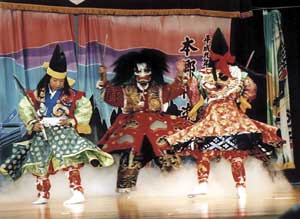
http://web-japan.org/kidsweb/master/kagura/1-art01.html
Kagura Dance and Music are part of the Shinto Rituals for the Gods, relating to ancient legends and were performed by priests and shrine maidens.
Now in some rural areas it is counted as a form of local art (minzoku geinoo) and preformed by the villagers themselves during the annual shrine festival. Some are are more like festive folk-drama. The area of Chichibu is especially known for its local kagura.
Some performances last more than one day. Even children perform in local kagura performances (kodomo kagura 子供神楽).
Masks made from Japanese paper (washi) are used and most old costumes are very precious.
There are various kagura types throughout Japan, see below.
:::::::::::::::::::::::::::::::::::::::::::::::::::::::::::::::::::::::::::::::::::::::::::::::::::::
The Mikagura 御神楽 style of Shinto is also known as kagura and is very similar to the court music of gagaku. The original dance was performed by the goddess Ama no Uzume no Mikoto to entice out the sun goddess into the world.
With time, Buddhist song-texts were introduced and the hichiriki, kagurabue, wagon and the shakubyoshi all came to be the instruments routinely used to accompany the songs. Only fifteen songs out of the repertoire are now performed and generally last about seven hours. The present performance tradition dates from the Meiji times.
The all male singers are divided into two groups; the motokata and the suekata, each with its own set of songs and a principal singer who accompanies himself on the shakubyoshi until the other singers and instruments enter at a point known as tsukedokoro. The song texts include some of the oldest known Japanese poetry.
The style is in general slow and solemn with the voice pure and unembellished. The notation is a system of neumes known as hakase, modelled on the notation for Buddhist chant, dating from the 12th century. The sumifu system has been in use since Meiji.
The Satokagura 里神楽 style of Shinto is distinct from the court kagura and instead features older ritual styles similar to that performed at Shinto shrines. This style of music involves the preparation of a shinza or place of worship to which the gods are invited. A priestess or miko is central to the ritual which is generally performed on winter evenings.
Satokagura can be subdivided into groups. One of the groups, Izumo kagura 出雲神楽, occurs throughout Japan, especially in the West and its main features are a series of dances performed with torimono (various ritual objects held by the dancers), followed by a noh play.
Another group, Ise kagura 伊勢神楽 is found in Kyoto and in the North and involves a ceromony known as yutate in which warm or boiling water is sprinkled about.
Edo kagura 江戸神楽 is found in Eastern Japan, especially Tokyo and is similar to Izumo kagura but is also influenced by mibu kyogen (a type of Buddhist morality play).
Other sub-groups include the Shishikagura 獅子神楽 which includes a lion dance (shishi-mai) and is now found in many forms throughout Japan and Yamabushi kagura 山伏神楽 which was originally performed by mountain ascetics. It embodies the eclectic, folk religious worldview of the Shugendo tradition.
With time, Satokagura took on a more theatrical form when special dance-halls were built especially for this style known as kaguradono. Accompanying instruments are generally found to be stick drums and transverse flutes. The rhythms are strong and lively.
http://www.digital-daydreams.com/enc/world/show_country.php?id=32
:::::::::::::::::::::::::::::::::::::::::::::::::::::::::::::::::::::::::::::::::::::::::::::::::::::
Iwami Kagura 石見神楽
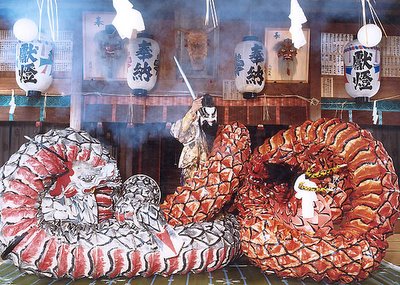
As a result of the evil deeds of her brother Susano-wo, the sun-goddess Amaterasu-omikami hid herself in the Cave of Heaven.
Susano, having been chased from Heaven, wandered across the continent of China until he crossed into the land of Izumo (modern Shimane prefecture) and came to the River Hi, where he met Princess Inada and an old couple wailing and lamenting.
When Susano asked why they were so upset, he was told that every year the terrible eight-headed serpent Yamato-no-Orochi appeared, and that it had already devoured seven of their daughters and would soon come to take their remaining child, Princess Inada. Susano soon formulated a plan and made the Orochi drink some poisoned sake brewed from various nuts, and then killed it whilst it was drunk.
He then recovered from the monster’s tail a sword that he named Ame-no-murakumo-no-tsurugi (Treasure Sword of Heaven) and presented it to his sister Amaterasu. He then married Princess Inada.
http://www.city.hamada.shimane.jp/en/kagura/orochi.htm
:::::::::::::::::::::::::::::::::::::::::::::::::::::::::::::::::::::::::::::::::::::::::::::::::::::
Miko Kagura 巫女神楽
a traditional dance in honour of the gods, performed by the maidens and priestesses (miko) of a shrine. Also called Miko Dance (miko mai 巫女舞).
:::::::::::::::::::::::::::::::::::::::::::::::::::::::::::::::::::::::::::::::::::::::::::::::::::::
Orochi Kagura, performed in the Izumo area
Orochi is a giant serpent which threatenes the local population. Yamata no Orochi (八岐大蛇、八俣遠呂智、八俣遠呂知 ー ヤマタノオロチ), a Serpent with eight heads is killed by the Deity Susa-no-O (Susano)、as we have seen in Iwami Kagura.
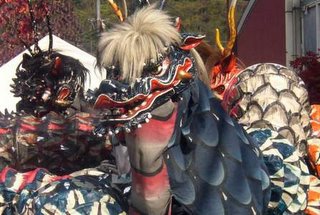
© Jake Davies / http://www.japanvisitor.com/ikj/ji/242.html
. Yamata no Orochi 八岐の大蛇 Serpent with eight heads .
papermachee figures from Tottori
:::::::::::::::::::::::::::::::::::::::::::::::::::::::::::::::::::::::::::::::::::::::::::::::::::::
Matsumae Kagura 松前神楽, Hokkaido
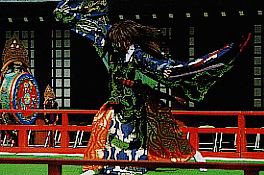
The kagura style of dance and music is performed in the course of worshiping Shinto gods and this type of performance is best represented by the Matsumae kagura. It is believe to have been performed first in 1674 at Matsumae castle, formerly Fukuyama, being officially appointed to Lord Norihiro, the 6th head of the Matsumae clan.
Kagura of this style is performed mainly at shrines in the south of Hokkaido. The fact that the Matsumae Kagura is traditionally performed and transmitted by the Shinto priests alone has contributed to the refinement of its artistry. Among the kagura dances performed by ordinary people is the Sanjo Kagura which is a variation of the kagura from Hachimangu Shrine in Sanjo city in Niigata prefecture.
Also known as Dai Dai kagura, this particular style of performance was adopted by the Hokkaido Shrine, the Sumiyoshi Shrine in Otaru, the Muroran Hachiman Shrine, the Nopporo Shrine and the Takikawa Shrine among others, though kagura is no longer performed at the Takikawa Shrine.
Kagura of this sort was developed after the settlers who came from the Sanjo area invited performers of ancient court music from their town of origin to dedicate their performance to the shrine. The Dai Dai kagura is performed by ordinary people of the community unlike the Matsumae Kagura which is performed by priests.
http://www.pref.hokkaido.jp/kseikatu/ks-bsbsk/digest/chapter_9.html
dai dai kagure, daidai kagura ダイダイ神楽 / 太太神楽 / 太々神楽
:::::::::::::::::::::::::::::::::::::::::::::::::::::::::::::::::::::::::::::::::::::::::::::::::::::
Dai Kagura, Daikagura 太神楽 Edo Daikagura
Dai Kagura is a remnant of the activities of Shinto dance troupes in the Edo Period, who brought Kagura (God-Music) performances to the local people who could not worship at Ise Shrine. The troupes who traveled around Western Japan throughout the year gathered on annually on the afternoon of December 24 at the Masuda Shrine of the main actor to perform all their acts as offerings.
The performers used some special words with different meanings, for example:
fukareru - to be turned down
gomui - bad
gosha, go sha - five yen
hitotsubo - 1,8 liter, 1 sho
mochi - police
mokoi - good
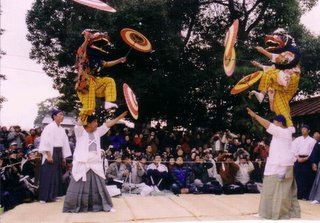
source : 2005. Mie Prefecture
ooooooooooooooooooooooooooooooooooooooooo
- quote -
What is “Edo-Daikagura”? Who is Senmaru?

Senmaru is a performer of “Edo-Daikagura”. “Edo” is an old name of Tokyo. “Daikagura”, it is very difficult to explain it.
Reportedly, the original purpose of Daikagura was to serve as a talisman for the people, chasing away evil on behalf of Jingu (the grand Shintoism shrines). Thus, Daikagura was originally a very sacred and serious performance. Today, the performance is becoming people’s entertainment. Senmaru wears a “kimono” and performs Japanese traditional tricks.
- source : senmaru.info/english... -
ooooooooooooooooooooooooooooooooooooooooo
太神楽(だいかぐら)は古くより神社に伝わる「伎楽(ぎがく)・散楽(さんがく)」の一部で、伊勢神宮・熱田神宮の二ヶ所が発祥の地と伝えられています。
江戸開府と共に出府し、獅子舞を連れて氏子の家々を廻りお祓いをする風習が生まれました。神様に代わって悪魔祓いの獅子舞を演じたことから、代神楽(だいかぐら)とも呼ばれていました。
神様への「奉納」・氏子への「祈祷」等が主な内容だった太神楽は、寄席の出現に伴い「神事芸能」から「舞台芸能」へと変化をし、獅子舞の余興として演じていた曲芸は大衆への娯楽を提供する「寄席芸能」へと発展してきました。
江戸時代に始まったこの「太神楽曲芸」は、明治・大正・昭和と時代に合わせた技を取り入れ、平成の今へと受け継がれている伝統芸能です。
太神楽は「舞」・「曲芸」・「話芸」・「鳴り物」の四つの柱から成り立っています。
http://www.daikagura.jp/kaisetsu.html
:::::::::::::::::::::::::::::::::::::::::::::::::::::::::::::::::::::::::::::::::::::::::::::::::::::
Locating Transcendence in Japanese Minzoku Geinô:
Yamabushi and Miko Kagura
Lisa Kuly
Cornell University, Ithaca, New York 2003
Contemporary minzoku geinô (minzoku geinoo, folk performing arts) in Japanese society is associated with the matsuri, or festival. Community members, such as workers and students, practise and perform various types of minzoku geinô in preparation for local festivals.
However, a look at the history of minzoku geinô reveals that originally its practitioners were marginalized members of society, who used ecstatic expression to perform various rites such as healings, exorcisms, and blessings.
Furthermore, the attitude toward ritual specialists was often negative; indeed, shamanistic practices were prohibited during the Meiji period (1868-1912). In response to social attitudes, ecstatic performers of Japan's premodern period negotiated their expressive powers in a variety of ways in order to survive.
This paper introduces the reader to the typology of minzoku geinô that involves ecstatic performance presented by yamabushi, male mountain-dwelling ascetics, and miko, female shamans generally associated with Shinto shrines. Moreover, the discussion in this paper illustrates how ecstatic performance changed throughout history to the extent that it is now seldom performed by marginalized ritual specialists.
Performers of contemporary minzoku geinô are accepted members of society. Furthermore, both the performers and the audience of minzoku geinô are affected by the transformative nature of ecstatic expression.
http://www.fl.ulaval.ca/celat/acef/kulya.htm
:::::::::::::::::::::::::::::::::::::::::::::::::::::::::::::::::::::::::::::::::::::::::::::::::::::
- - - - - Further Links in the Daruma Museum:
. Mask of Ko-Daruma for Satokagura
小だるまの面
. Kagura at Kirishima Shrine 霧島神宮 .
Kagura, by Kids Web Japan
Iwami Kagura 石見神楽
Tengai : Canopy and Iwami Kagura
Musical Instruments (01)
:::::::::::::::::::::::::::::::::::::::::::::::::::::::::::::::::::::::::::::::::::::::::::::::::::::
source : edoichiba menutisyoku
menuchi shokunin 面打職人 craftsmen making masks
They make masks for 神楽面 Kagura dance and 能面 Noh performances.
The wood used most often is kusunoki 楠 camphor, hinoki 檜 cypress and kiri 桐 paulownia.
. Edo no shokunin 江戸の職人 Edo craftsmen .
:::::::::::::::::::::::::::::::::::::::::::::::::::::::::::::::::::::::::::::::::::::::::::::::::::::
Other Links
神話と里神楽の神々 (非常に詳しい資料)
神楽は神遊びともいい、
宮廷で神を祭る際の舞楽で、もつぱら神前で奏する音楽。 天宇受売命を遠祖とする猿女が代々伝えてきた。
これ対する一般の神楽を里神楽という。
九州 : 日向神楽、佐伯神楽、平戸神楽。
中国・山陰・山陽 :
大社神楽、佐陀神楽、備前神楽。
四国 : 伊予神楽。
近畿・中部 : 巫女神楽、花祭り。
関東 : 里神楽、岩戸神楽。
東北 : 番神楽、山伏神楽。
北海道 : 松前神楽。
http://www.asahi-net.or.jp/~pq7s-nsmr/nof_shinwa.htm
子供神楽, 写真がいっぱい
Childrens Kagura with many photos
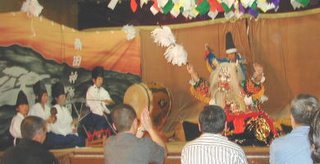
From 2000
http://ww3.enjoy.ne.jp/~ahmsm.kuwata/child/child.html
:::::::::::::::::::::::::::::::::::::::::::::::::::::::::::::::::::::::::::::::::::::::::::::::::::::

KAGURA as a kigo for haiku !
:::::::::::::::::::::::::::::::::::::::::::::::::::::::::::::::::::::::::::::::::::::::::::::::::::::
[ . BACK to WORLDKIGO . TOP . ]
[ . BACK to DARUMA MUSEUM TOP . ]
- #kagura #daikagura #daidai -
:::::::::::::::::::::::::::::::::::::::::::::::::::::::::::::::::::::::::::::::::::::::::::::::::::::
. Yamata no orochi 山田の大蛇 huge monster serpent .
:::::::::::::::::::::::::::::::::::::::::::::::::::::::::::::::::::::::::::::::::::::::::::::::::::::
Kagura Dance 神楽

http://web-japan.org/kidsweb/master/kagura/1-art01.html
Kagura Dance and Music are part of the Shinto Rituals for the Gods, relating to ancient legends and were performed by priests and shrine maidens.
Now in some rural areas it is counted as a form of local art (minzoku geinoo) and preformed by the villagers themselves during the annual shrine festival. Some are are more like festive folk-drama. The area of Chichibu is especially known for its local kagura.
Some performances last more than one day. Even children perform in local kagura performances (kodomo kagura 子供神楽).
Masks made from Japanese paper (washi) are used and most old costumes are very precious.
There are various kagura types throughout Japan, see below.
:::::::::::::::::::::::::::::::::::::::::::::::::::::::::::::::::::::::::::::::::::::::::::::::::::::
The Mikagura 御神楽 style of Shinto is also known as kagura and is very similar to the court music of gagaku. The original dance was performed by the goddess Ama no Uzume no Mikoto to entice out the sun goddess into the world.
With time, Buddhist song-texts were introduced and the hichiriki, kagurabue, wagon and the shakubyoshi all came to be the instruments routinely used to accompany the songs. Only fifteen songs out of the repertoire are now performed and generally last about seven hours. The present performance tradition dates from the Meiji times.
The all male singers are divided into two groups; the motokata and the suekata, each with its own set of songs and a principal singer who accompanies himself on the shakubyoshi until the other singers and instruments enter at a point known as tsukedokoro. The song texts include some of the oldest known Japanese poetry.
The style is in general slow and solemn with the voice pure and unembellished. The notation is a system of neumes known as hakase, modelled on the notation for Buddhist chant, dating from the 12th century. The sumifu system has been in use since Meiji.
The Satokagura 里神楽 style of Shinto is distinct from the court kagura and instead features older ritual styles similar to that performed at Shinto shrines. This style of music involves the preparation of a shinza or place of worship to which the gods are invited. A priestess or miko is central to the ritual which is generally performed on winter evenings.
Satokagura can be subdivided into groups. One of the groups, Izumo kagura 出雲神楽, occurs throughout Japan, especially in the West and its main features are a series of dances performed with torimono (various ritual objects held by the dancers), followed by a noh play.
Another group, Ise kagura 伊勢神楽 is found in Kyoto and in the North and involves a ceromony known as yutate in which warm or boiling water is sprinkled about.
Edo kagura 江戸神楽 is found in Eastern Japan, especially Tokyo and is similar to Izumo kagura but is also influenced by mibu kyogen (a type of Buddhist morality play).
Other sub-groups include the Shishikagura 獅子神楽 which includes a lion dance (shishi-mai) and is now found in many forms throughout Japan and Yamabushi kagura 山伏神楽 which was originally performed by mountain ascetics. It embodies the eclectic, folk religious worldview of the Shugendo tradition.
With time, Satokagura took on a more theatrical form when special dance-halls were built especially for this style known as kaguradono. Accompanying instruments are generally found to be stick drums and transverse flutes. The rhythms are strong and lively.
http://www.digital-daydreams.com/enc/world/show_country.php?id=32
:::::::::::::::::::::::::::::::::::::::::::::::::::::::::::::::::::::::::::::::::::::::::::::::::::::
Iwami Kagura 石見神楽

As a result of the evil deeds of her brother Susano-wo, the sun-goddess Amaterasu-omikami hid herself in the Cave of Heaven.
Susano, having been chased from Heaven, wandered across the continent of China until he crossed into the land of Izumo (modern Shimane prefecture) and came to the River Hi, where he met Princess Inada and an old couple wailing and lamenting.
When Susano asked why they were so upset, he was told that every year the terrible eight-headed serpent Yamato-no-Orochi appeared, and that it had already devoured seven of their daughters and would soon come to take their remaining child, Princess Inada. Susano soon formulated a plan and made the Orochi drink some poisoned sake brewed from various nuts, and then killed it whilst it was drunk.
He then recovered from the monster’s tail a sword that he named Ame-no-murakumo-no-tsurugi (Treasure Sword of Heaven) and presented it to his sister Amaterasu. He then married Princess Inada.
http://www.city.hamada.shimane.jp/en/kagura/orochi.htm
:::::::::::::::::::::::::::::::::::::::::::::::::::::::::::::::::::::::::::::::::::::::::::::::::::::
Miko Kagura 巫女神楽
a traditional dance in honour of the gods, performed by the maidens and priestesses (miko) of a shrine. Also called Miko Dance (miko mai 巫女舞).
:::::::::::::::::::::::::::::::::::::::::::::::::::::::::::::::::::::::::::::::::::::::::::::::::::::
Orochi Kagura, performed in the Izumo area
Orochi is a giant serpent which threatenes the local population. Yamata no Orochi (八岐大蛇、八俣遠呂智、八俣遠呂知 ー ヤマタノオロチ), a Serpent with eight heads is killed by the Deity Susa-no-O (Susano)、as we have seen in Iwami Kagura.

© Jake Davies / http://www.japanvisitor.com/ikj/ji/242.html
. Yamata no Orochi 八岐の大蛇 Serpent with eight heads .
papermachee figures from Tottori
:::::::::::::::::::::::::::::::::::::::::::::::::::::::::::::::::::::::::::::::::::::::::::::::::::::
Matsumae Kagura 松前神楽, Hokkaido

The kagura style of dance and music is performed in the course of worshiping Shinto gods and this type of performance is best represented by the Matsumae kagura. It is believe to have been performed first in 1674 at Matsumae castle, formerly Fukuyama, being officially appointed to Lord Norihiro, the 6th head of the Matsumae clan.
Kagura of this style is performed mainly at shrines in the south of Hokkaido. The fact that the Matsumae Kagura is traditionally performed and transmitted by the Shinto priests alone has contributed to the refinement of its artistry. Among the kagura dances performed by ordinary people is the Sanjo Kagura which is a variation of the kagura from Hachimangu Shrine in Sanjo city in Niigata prefecture.
Also known as Dai Dai kagura, this particular style of performance was adopted by the Hokkaido Shrine, the Sumiyoshi Shrine in Otaru, the Muroran Hachiman Shrine, the Nopporo Shrine and the Takikawa Shrine among others, though kagura is no longer performed at the Takikawa Shrine.
Kagura of this sort was developed after the settlers who came from the Sanjo area invited performers of ancient court music from their town of origin to dedicate their performance to the shrine. The Dai Dai kagura is performed by ordinary people of the community unlike the Matsumae Kagura which is performed by priests.
http://www.pref.hokkaido.jp/kseikatu/ks-bsbsk/digest/chapter_9.html
dai dai kagure, daidai kagura ダイダイ神楽 / 太太神楽 / 太々神楽
:::::::::::::::::::::::::::::::::::::::::::::::::::::::::::::::::::::::::::::::::::::::::::::::::::::
Dai Kagura, Daikagura 太神楽 Edo Daikagura
Dai Kagura is a remnant of the activities of Shinto dance troupes in the Edo Period, who brought Kagura (God-Music) performances to the local people who could not worship at Ise Shrine. The troupes who traveled around Western Japan throughout the year gathered on annually on the afternoon of December 24 at the Masuda Shrine of the main actor to perform all their acts as offerings.
The performers used some special words with different meanings, for example:
fukareru - to be turned down
gomui - bad
gosha, go sha - five yen
hitotsubo - 1,8 liter, 1 sho
mochi - police
mokoi - good

source : 2005. Mie Prefecture
ooooooooooooooooooooooooooooooooooooooooo
- quote -
What is “Edo-Daikagura”? Who is Senmaru?

Senmaru is a performer of “Edo-Daikagura”. “Edo” is an old name of Tokyo. “Daikagura”, it is very difficult to explain it.
Reportedly, the original purpose of Daikagura was to serve as a talisman for the people, chasing away evil on behalf of Jingu (the grand Shintoism shrines). Thus, Daikagura was originally a very sacred and serious performance. Today, the performance is becoming people’s entertainment. Senmaru wears a “kimono” and performs Japanese traditional tricks.
- source : senmaru.info/english... -
ooooooooooooooooooooooooooooooooooooooooo
太神楽(だいかぐら)は古くより神社に伝わる「伎楽(ぎがく)・散楽(さんがく)」の一部で、伊勢神宮・熱田神宮の二ヶ所が発祥の地と伝えられています。
江戸開府と共に出府し、獅子舞を連れて氏子の家々を廻りお祓いをする風習が生まれました。神様に代わって悪魔祓いの獅子舞を演じたことから、代神楽(だいかぐら)とも呼ばれていました。
神様への「奉納」・氏子への「祈祷」等が主な内容だった太神楽は、寄席の出現に伴い「神事芸能」から「舞台芸能」へと変化をし、獅子舞の余興として演じていた曲芸は大衆への娯楽を提供する「寄席芸能」へと発展してきました。
江戸時代に始まったこの「太神楽曲芸」は、明治・大正・昭和と時代に合わせた技を取り入れ、平成の今へと受け継がれている伝統芸能です。
太神楽は「舞」・「曲芸」・「話芸」・「鳴り物」の四つの柱から成り立っています。
http://www.daikagura.jp/kaisetsu.html
:::::::::::::::::::::::::::::::::::::::::::::::::::::::::::::::::::::::::::::::::::::::::::::::::::::
Locating Transcendence in Japanese Minzoku Geinô:
Yamabushi and Miko Kagura
Lisa Kuly
Cornell University, Ithaca, New York 2003
Contemporary minzoku geinô (minzoku geinoo, folk performing arts) in Japanese society is associated with the matsuri, or festival. Community members, such as workers and students, practise and perform various types of minzoku geinô in preparation for local festivals.
However, a look at the history of minzoku geinô reveals that originally its practitioners were marginalized members of society, who used ecstatic expression to perform various rites such as healings, exorcisms, and blessings.
Furthermore, the attitude toward ritual specialists was often negative; indeed, shamanistic practices were prohibited during the Meiji period (1868-1912). In response to social attitudes, ecstatic performers of Japan's premodern period negotiated their expressive powers in a variety of ways in order to survive.
This paper introduces the reader to the typology of minzoku geinô that involves ecstatic performance presented by yamabushi, male mountain-dwelling ascetics, and miko, female shamans generally associated with Shinto shrines. Moreover, the discussion in this paper illustrates how ecstatic performance changed throughout history to the extent that it is now seldom performed by marginalized ritual specialists.
Performers of contemporary minzoku geinô are accepted members of society. Furthermore, both the performers and the audience of minzoku geinô are affected by the transformative nature of ecstatic expression.
http://www.fl.ulaval.ca/celat/acef/kulya.htm
:::::::::::::::::::::::::::::::::::::::::::::::::::::::::::::::::::::::::::::::::::::::::::::::::::::
- - - - - Further Links in the Daruma Museum:
. Mask of Ko-Daruma for Satokagura
小だるまの面
. Kagura at Kirishima Shrine 霧島神宮 .
Kagura, by Kids Web Japan
Iwami Kagura 石見神楽
Tengai : Canopy and Iwami Kagura
Musical Instruments (01)
:::::::::::::::::::::::::::::::::::::::::::::::::::::::::::::::::::::::::::::::::::::::::::::::::::::
source : edoichiba menutisyoku
menuchi shokunin 面打職人 craftsmen making masks
They make masks for 神楽面 Kagura dance and 能面 Noh performances.
The wood used most often is kusunoki 楠 camphor, hinoki 檜 cypress and kiri 桐 paulownia.
. Edo no shokunin 江戸の職人 Edo craftsmen .
:::::::::::::::::::::::::::::::::::::::::::::::::::::::::::::::::::::::::::::::::::::::::::::::::::::
Other Links
神話と里神楽の神々 (非常に詳しい資料)
神楽は神遊びともいい、
宮廷で神を祭る際の舞楽で、もつぱら神前で奏する音楽。 天宇受売命を遠祖とする猿女が代々伝えてきた。
これ対する一般の神楽を里神楽という。
九州 : 日向神楽、佐伯神楽、平戸神楽。
中国・山陰・山陽 :
大社神楽、佐陀神楽、備前神楽。
四国 : 伊予神楽。
近畿・中部 : 巫女神楽、花祭り。
関東 : 里神楽、岩戸神楽。
東北 : 番神楽、山伏神楽。
北海道 : 松前神楽。
http://www.asahi-net.or.jp/~pq7s-nsmr/nof_shinwa.htm
子供神楽, 写真がいっぱい
Childrens Kagura with many photos

From 2000
http://ww3.enjoy.ne.jp/~ahmsm.kuwata/child/child.html
:::::::::::::::::::::::::::::::::::::::::::::::::::::::::::::::::::::::::::::::::::::::::::::::::::::

KAGURA as a kigo for haiku !
:::::::::::::::::::::::::::::::::::::::::::::::::::::::::::::::::::::::::::::::::::::::::::::::::::::
[ . BACK to WORLDKIGO . TOP . ]
[ . BACK to DARUMA MUSEUM TOP . ]
- #kagura #daikagura #daidai -
:::::::::::::::::::::::::::::::::::::::::::::::::::::::::::::::::::::::::::::::::::::::::::::::::::::
Subscribe to:
Comments (Atom)









